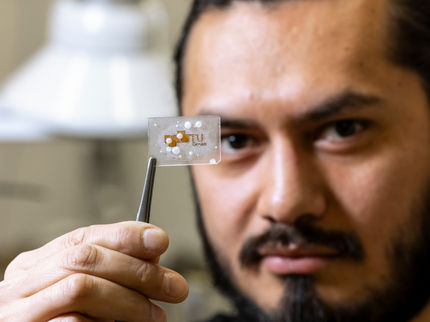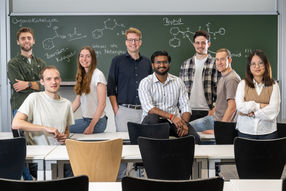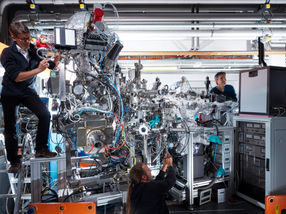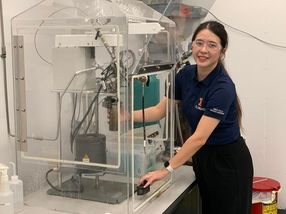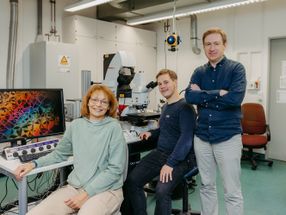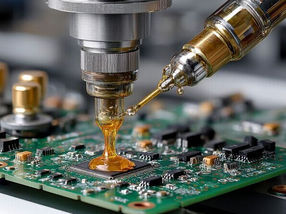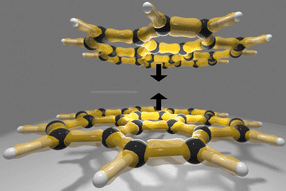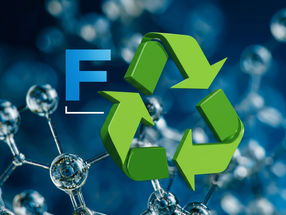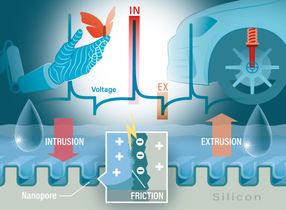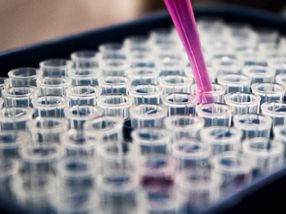A mineral provides the template: peptides assemble into arrays of flat nanotapes on mica surfaces
Advertisement
composite materials are catching on in technological applications. Take for example the hybrid structures of metal and plastics that are incorporated into many components of our cars. Nature also frequently works with an interesting class of composite materials: composites of proteins and inorganic compounds. In these cases, the proteins usually act as a kind of instruction set for the assembly of the mineral components into a precisely defined structure. This is how the bizarre frameworks of diatoms are formed, for example, as well as our teeth. Contrastingly, inorganic "substrates" can also induce proteins to aggregate into extended structures. A team of British and American researchers has now put a new slant on these processes.
The work itself was done primarily by Conor Whitehouse, working in a group headed by Neville Boden. This group have been learning in recent years how to make small peptides, which, above a particular concentration in solution, have the unique ability to spontaneously self-assemble into long tape-like aggregates a single molecule in thickness-reminiscent of pieces of tagliatelle. These small tagliatelle are twisted and this causes them to intertwine each other and stack into more complex fibrils that look just like pieces of fusili.
Surprising things happen when a solution containing single, isolated molecules of these peptides is deposited onto a muskovite surface. Muskovite is a mica, a scaly mineral with a pearlescent shine. Here the peptide molecules undergo side-by-side self-assembly into elongated, flattened, tapes. The tapes only grow in length until they bump into another tape, which results in a "monolayer". "Thus, the tapes are not twisted as they are in solution; instead, they lie flat on the surface," reports Whitehouse. "They have to untwist themselves, which they do when the binding energy between the peptide and the mica is high enough," says Whitehouse, "what holds the tapes on the mica appears to be an electrostatic attraction between charged groups in the peptides and oppositely charged ions in the crystal lattice."
When in contact with solution, the tapes have a hexagonal arrangement reflecting the symmetry of the mica surface. However, when the solvent is carefully removed, the organization of the tapes on the surface changes dramatically. "We can thus obtain densely packed monolayers of tapes with an extended parallel organization," says Whitehouse, "this is practically important because it enables surface coatings to be made into which protein-like functionality could be incorporated."
Most read news
Topics
Organizations
Other news from the department science
These products might interest you

Dursan by SilcoTek
Innovative coating revolutionizes LC analysis
Stainless steel components with the performance of PEEK - inert, robust and cost-effective
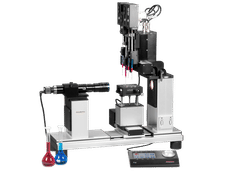
OCA 200 by DataPhysics
Using contact angle meter to comprehensively characterise wetting behaviour, solids, and liquids
With its intuitive software and as a modular system, the OCA 200 answers to all customers’ needs

Tailor-made products for specific applications by IPC Process Center
Granulates and pellets - we develop and manufacture the perfect solution for you
Agglomeration of powders, pelletising of powders and fluids, coating with melts and polymers

Get the chemical industry in your inbox
By submitting this form you agree that LUMITOS AG will send you the newsletter(s) selected above by email. Your data will not be passed on to third parties. Your data will be stored and processed in accordance with our data protection regulations. LUMITOS may contact you by email for the purpose of advertising or market and opinion surveys. You can revoke your consent at any time without giving reasons to LUMITOS AG, Ernst-Augustin-Str. 2, 12489 Berlin, Germany or by e-mail at revoke@lumitos.com with effect for the future. In addition, each email contains a link to unsubscribe from the corresponding newsletter.
Most read news
More news from our other portals
Last viewed contents
BGU researchers invent green alternative to crude oil - Researchers at the Blechner Center have developed a revolutionary process to convert carbon dioxide and hydrogen into a green feed that can be refined into renewable liquid fuels
Aventis implements SciQuest's Enterprise Substance Manager to establish common logistics infrastructure for research facilities
Zeon Commercializes High-Performance TPV - Zeotherm
Photonics industry commits to more than 5 billion Euros investment in Europe

New clues help explain why PFAS chemicals resist remediation - Work suggests new avenues for cleaning up these 'forever chemicals'
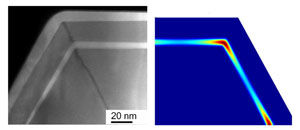
Secret of the crystal's corners - New nanowire structure has potential to increase semiconductor applications
Bayer MaterialScience lifts force majeure for TDI in Europe
Committed to sustainability and innovation: Cognis adopts 24 principles of Green Chemistry and Green Engineering




